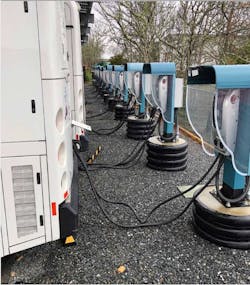Case study: How PXiSE’s microgrid controller optimizes Martha’s Vineyard microgrid
When vacationers leave the big city behind for a serene seaside retreat like Martha’s Vineyard, they’re often looking for an escape from the noise and air pollution that go along with city life. This was one of the motivations behind the Martha’s Vineyard Transit Authority’s (VTA) goal to switch to an all-electric bus fleet to serve the island. But adding electrical load to an already-taxed island electrical grid is no small undertaking, especially when the high draw of electric bus chargers is involved. Plus, the stakes are high when it comes to ensuring reliable transit, regardless of weather or the availability of power from the larger grid.
The solution was to develop a microgrid, powered by VTA’s solar photovoltaic (PV) array, that includes battery energy storage. In addition to providing the VTA with the required resiliency, such a microgrid helps offset the high cost of power on the island, both by generating its own electricity through the solar PV array and by taking advantage of demand response and load shifting opportunities.
The lean staffing environment at the VTA also meant that the microgrid must operate and manage all its resources autonomously — a tall order given the diverse asset management and demand response requirements that are layered onto local system constraints. Specifically, the microgrid requires a controller that can:
- Coordinate a battery energy storage system, solar PV array, backup diesel generator and large power load from the bus chargers all on a limited 1-MW power system.
- Mitigate the negative effects of the intermittent power generation coming from the solar PV array.
- Enable the VTA to sell excess power into the grid.
- Optimize for demand response and avoid peak power rates.
- Ensure that a minimum level of transit operations continues even during larger grid failures.
The team at PXiSE Energy Solutions knew their microgrid controller met these requirements and began the process of setting up an autonomous system for VTA. They started by analyzing historical load and weather data on Martha’s Vineyard, prior electric bills and the seasonal bus schedule on the island to assess charging demand. They loaded that processed data set into the controller, which uses artificial intelligence to conduct further analysis in real time to compare the historical data with current weather forecasts, solar PV production data, as well as the tariff structure. This enables the controller to plan 24 hours ahead, optimizing the powering up and down of the microgrid’s assets while adjusting for real-time data and running the microgrid autonomously so the VTA doesn’t require specialized staff.
The scalable system will grow with the VTA as it expands and installs additional microgrids throughout the island. As additional microgrids are added, each will operate independently and primarily remain connected to the main grid. If an unexpected disturbance occurs on the main grid, high speed sensors (synchrophasors) alert the system, which switches the microgrid to island mode within two cycles (~38ms). If an extended outage occurs, the controller automatically triggers start up of the backup generator, which recharges the system when the solar PV and battery power can’t meet power demands. The controller then continuously monitors the external grid for reconnection opportunities and manages the power flow on the microgrid so it can resynchronize with the external grid the instant the opportunity arises.
The success of this project demonstrates how the addition of a software-based controller can turn a complex microgrid configuration into a reliable, low-maintenance system that provides both environmental and economic benefits.
Read more from PXiSE at microgridknowledge.com.








